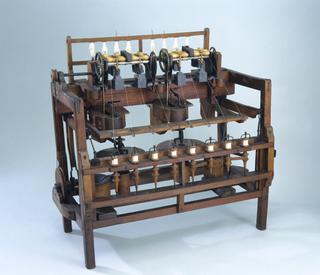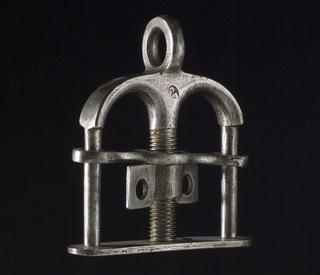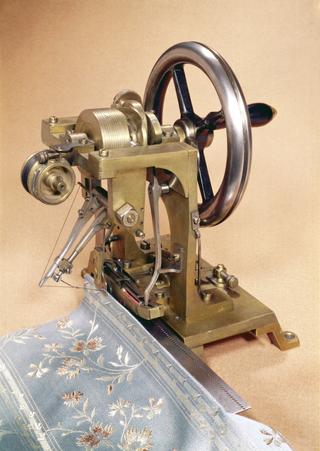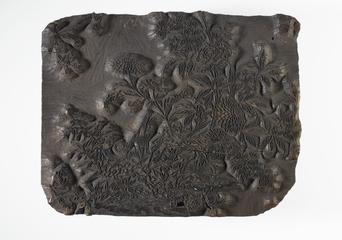
Carding machine by Richard Arkwright, 1775, believed to be from Cromford Mill, Derbyshire.
- Made:
- c.1775 in England
- inventor:
- Richard Arkwright
Carding machine by Sir Richard Arkwright (1732-1792), England, 1771-1780. Believed to be from Cromford Mill, Derbyshire.
Richard Arkwright is indelibly associated with the changes in production that came to be known as the 'Industrial Revolution’. His particular talent was for exploiting innovation rather than actual invention and his machines all had origins in earlier efforts by others.
Arkwright’s lasting monument is the factory (or mill, as it was known in the textile industry). This concept arose from his appreciation that the manufacture of cotton yarn was a series of operations which could be undertaken in sequence by a suite of special purpose machines, gathered together in a single place and driven by a single power source.
Before Arkwright’s innovations most textiles were made in the homes of the spinners and weavers and the production of cotton was low, relative to wool and linen. After Arkwright, production became centralised in factories, designed to make efficient use of a range of machines, and to allow the management of labour.
The Arkwright system helped to establish Britain’s position in the nineteenth century as the world leader in textile production, but it also had wider international effects. British machine spinning led to the destruction of the Indian cotton spinning industry, while demand for raw cotton sustained the slave economy in the USA.
This machine, made by Sir Richard Arkwright about the year 1775, is very similar to the cylindrical carding engine invented and constructed by Daniel Bourn, of Leominster, in 1748. The object of the machine is to remov from the cotton any fragments of leaves, seeds, etc., and also to straighten 14 out the fibres by a combing action. This is accomplished by small wire teeth fixed in leather strips upon three cylinders. The cylinders are arranged horizontally with their axes parallel, and by bands are rotated at different speeds. The cotton, having been previously ginned and beaten, was fed on by har to the small cylinder, which would now be called the licker-in. Its wire teeth, which are bent or set towards the direction of motion, lay hold of the fibres of cotton and carry them downward and round to the second or main cylinder. This moves in the same direction at the line of contact, and also has its teeth set in the direction of motion, but its surface velocity is about 80 times that of the licker-in, and this greater speed causes its teeth to take the cotton from the first cylinder, but at the same time, by a combing action, somewhat to straighten the fibres. The third, or doffer cylinder, has the same direction of motion at the line of contact as the main cylinder, but only one-tenth the surface velocity, and as its teeth are set in the opposite direction to that in which it moves, it takes the cotton from the teeth of the main cylinder. A reciprocating comb, which receives its motion from a crank on the axis of one of the pulleys, takes the carded cotton from the doffer cylinder and delivers it in strips. This comb was invented by James Hargreaves in 1773.
Details
- Category:
- Textiles Machinery
- Object Number:
- 1860-7
- Materials:
- wood (unidentified), iron, gut and steel (metal)
- Measurements:
-
overall: 1260 x 750 x 1220 mm (approximate)
- type:
- carding
- credit:
- Fothergill, Benjamin




